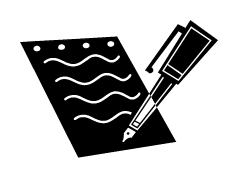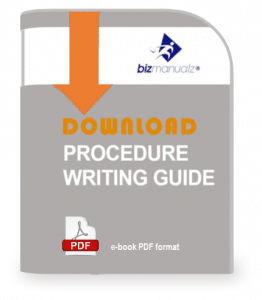How to Create an Effective Policy Procedure Manual

An effective policy procedure manual is clearly written and easily understood by all the employees in your organization. Remember that the objective of your policy procedure manual is to improve the efficiency of your company, establish business controls and to comply with established regulations. How to Create an Effective Policy Procedure Manual.
Creating An Effective Policy Procedure Manual
There are a lot of reasons for writing procedures. But, the most important rule when writing a policy procedure manual is that clarity and readability are much more important than style, perfect grammar and a large vocabulary.
Procedure Writing
The policy writer must try to put themselves into the position of the users at all times. It is a good idea to develop manual review criteria, to make sure your procedure document are consistent and correct. While developing policy and procedure statements to create an effective policy procedure manual, some general guidelines for the procedure writer to keep in mind are:
- Explain new or unusual terms the first time they are used or in the definitions section of the statement.
- Avoid jargon wherever possible, especially when training new employees.
- Avoid unneeded words.
- Avoid complex writing. If the writer’s vocabulary is unusually large or if they write using complex sentence structures, the writing may be at too high a level for many of the users. Understanding is far more important than the correctness of the language.
- Use active verbs instead of passive phrases.
- Write the way you speak. Use words and phrases that you would normally use in expressing the same thought orally.
Sexism in Procedure Writing
Webster’s New Collegiate Dictionary defines “he” as used in the generic sense or when the sex of the person is unspecified. However, many people will not accept “he” being used when referring to people in general. There have been suggestions that the generic “he” be replaced with “he or she” and “him” with “him or her.”
Another recent method that is gaining acceptance is the switch to a plural pronoun with a singular subject such as “When someone orders their supplies, they will have to complete a …”
When writing business policies and procedures, it is often it is more practical for the writer to use generic nouns or by recasting sentences to include positions or titles (i.e., Applicant, Manager, Accountant, Driver, etc.) to eliminate the need for most sexism in writing of policy and procedure statements.
Number Usage in Your Procedures
Writing procedures for results may often times include the frequent usage of numbers in the writing. The following rules cover how numbers should be used in print.
-
- Never begin a sentence with numbers. “Fifty states have been admitted to the union” not “50 states …”
- Spell numbers one through nine in words, 10 or larger in numerals.
- Compound numbers such as fractions in numerals, for example 8 1/2″ X 11.”
- When showing odds, use hyphens such as 4-to-1.
- Decimals of less than one should be preceded by a zero, for example, 0.5 percent.
- Dates: “the 1990s”
- Spell % as percent.
- Use numerals with times such as a.m. and p.m.
Organizing Your Procedure Ideas
To help the procedure writer formulate and organize ideas for developing and writing policy and procedure statements, it may be useful to outline the material to be covered. Outlining is a fast and effective way to show a great amount of information in a concise, efficient manner with a minimum of writing.
To achieve well-written and easily understood policy and procedure statements that flow in a cohesive and logical form, your personnel should first outline their thoughts before beginning to write a statement.
When outlining a policy and procedure statement, the following areas should be defined:
- What is the objective of the policy and procedure statement?
- What is the Company’s policy on this matter?
- Who does the business policy affect?
- When is the policy/procedure appropriate?
- How is the objective to be accomplished? This should include outlining major areas of your procedure in a step-by-step fashion in chronological order.
 Procedure Outlining
Procedure Outlining
There are some basic standard rules for effective and consistent procedure outlining. It may be helpful to briefly review a few of these that deal primarily with formatting. These rules concern indentation and numbering.
Standard outline formatting is as follows:
I.
A.
1.
2.
a.
b.
B.
II.
There should always be at least two of each type of character. For example, there should not be an I without a II, an A without a B, etc. The four characters to mark each section level, Roman numerals, capital letters, Arabic numerals and lower case letters are followed by a period. Line up the periods vertically for each type of character. Thus, Roman numerals are shown:
I.
II.
Arabic numerals are lined up as follows:
5.
39.
By aligning the periods, the text is a pleasing, straight vertical line. Indentation should be uniform, usually two to five spaces for each change in type of line. The part of a single line carried to a second line should be indented the same number of spaces as the original part of the line.
Avoid Procedure Problems
If you have a problem with your colleagues not knowing that procedures exists, or the existing procedure is not being used in your organization, there is a good chance there is room for improvement in one or more of these areas. What makes a good procedure good anyway?
Poorly Written Procedures
Perhaps the procedures themselves are too long, too confusing, too hard to use, poorly written and lacking verb power, and perhaps even hopelessly inaccurate. Such poorly written procedures are typically ignored in organizations, and for good reason. Pretty soon they are forgotten relics.
Poor Procedure Communication
If training and auditing methods are inadequate, then there may not be enough awareness of procedures. Throughout the organization, procedure training should explain and communicate why procedures are important, how to find them, how to change them if they are wrong, and what procedures are relevant to particular business processes.
Poor Document Control
Without a good system to manage your documents so people can easily find procedures, retrieve them, etc.., then once again there is good chance people will just ignore them. Good procedure document control is supposed to help members of the organization, not add an additional bureaucratic maze.
 Create An Effective Policy Procedure Manual
Create An Effective Policy Procedure Manual
An Effective Policy Procedure Manual is clearly written, easily understood by all the employees in your organization, and establishes a foundation of business controls that comply with established regulations. Clarity and readability are more important than style, perfect grammar and a large vocabulary. Download Free Policies and Procedures to see how easy it is to edit MS Word Templates to build your own policy and procedure management system.
















Leave a Reply